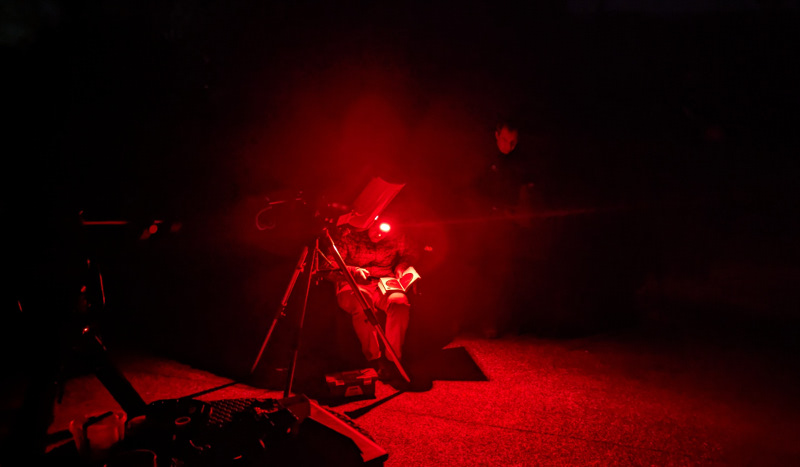NGC 3372 - Carina Nebula
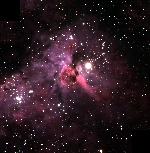 |
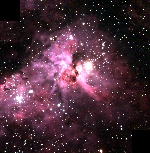 |
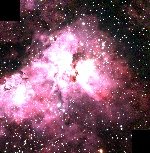 |
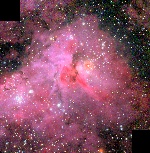 |
| Imax=3.50 | Imax=2 | Imax=1 | Nonlinear |
SBIG ST-4K with 10″ LX200 telescope, 1200s total exposure 2/16/23 Whangaparaoa, NZ
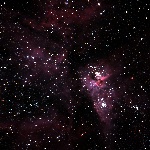 |
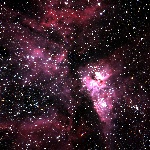 |
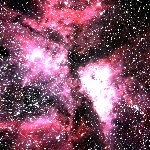 |
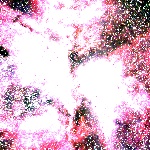 |
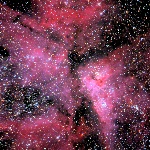 |
| Imax=30 | Imax=12 | Imax=4 | Imax=1 | Nonlinear |
SBIG ST-4K with 8″ f/4 Newtonian, 300s total exposure 2/21/23 Whangaparaoa, NZ
The Carina Nebula is a vast emission nebula rivaling the Orion and Lagoon Nebulae in the amount of visual detail that can be seen, though the Carina Nebula is actually more distant and larger. At a declination of -60°, it can only be seen well from southern latitudes. The image in the top row captures only the portion around η Carinae (the brightest star in the image, slightly above and to the right of center). The field of view includes a heart-like object near the center along with a number of dark pillars and globules spread across the image.
The second row shows another image of the Carina Nebula taken using the 8″ f/4 Newtonian scope to capture a wider field of view. At the lower magnification we can see the structure of the dark lanes that divide the nebula into several regions.
η Carinae
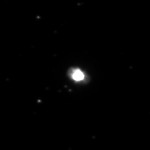 |
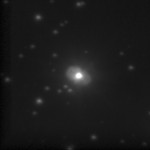 |
| Linear | Nonlinear |
Alvium 1800 U-319m with 10″ LX200 telescope, 300 x 1s exposures 2/16/23 Whangaparaoa, NZ
The star η Carinae, located near the brightest part of the Carina Nebula, is thought to be one of the most massive stars in our galaxy. From approximately 1837-1856, the star underwent the “Great Eruption” during which it briefly reached magnitude -1, becoming the second-brightest star in the sky. Afterwards it faded below naked-eye visibility, before slowly brightening again over the past 70 years to magnitude 4. Currently it is surrounded by a cloud of gas and dust known as the Homunculus Nebula, thought to be created by the event in the 1840s. Visually, it appears as two golden lobes very close to the star, which also has a golden color and is considerably brighter than the lobes. One of the lobes is brighter and easier to see than the other. I attempted to capture them using the monochrome CMOS camera to maximize resolution. The above images are stacked from 300 separate unguided exposures, using image registration and alignment. The image on the left is scaled linearly, while the image on the right uses a 1/4 power scaling to compress the dynamic range, making the shape of the lobes easier to see despite the large brightness disparities within the structure.
NGC 2070 - Tarantula Nebula
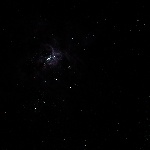 |
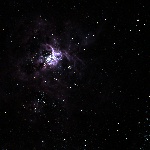 |
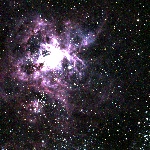 |
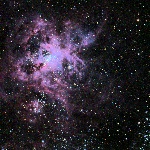 |
| Imax=35 | Imax=7 | Imax=1 | Nonlinear |
SBIG ST-4K with 10″ LX200 telescope, 600s total exposure 2/17/23 Whangaparaoa, NZ
The Tarantula Nebula, located in the Large Magellanic Cloud, is visually spectacular despite its distance of 160,000 light years, 120 times farther than the Orion Nebula. It includes a central star cluster, a number of chambers, some dark features, and numerous tentacles extending outwards, nearly connecting with neighboring, smaller nebulae (see additional photos below). Its size of approximately 1900 ly is comparable to the more distant NGC 604 in the Triangulum Galaxy.
Large Magellanic Cloud Nebulae
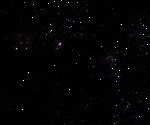 |
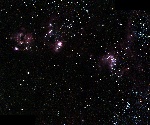 |
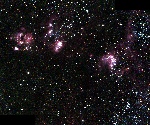 |
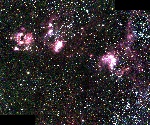 |
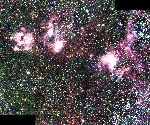 |
 |
| Imax=10 | Imax=2 | Imax=1 | Imax=0.50 | Imax=0.25 | Nonlinear |
SBIG ST-4K with 10″ LX200 telescope, 1200s total exposure 2/20/23 Whangaparaoa, NZ
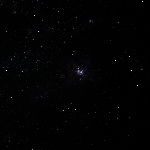 |
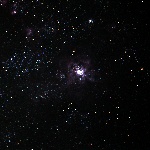 |
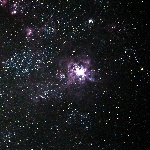 |
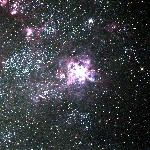 |
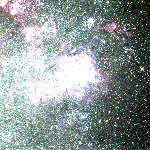 |
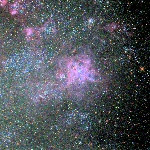 |
| Imax=90 | Imax=20 | Imax=7 | Imax=3 | Imax=1 | Nonlinear |
SBIG ST-4K with 8″ f/4 Newtonian, 300s total exposure 2/21/23 Whangaparaoa, NZ
The image in the top row captures a few of the other emission nebulae in the Large Magellanic Cloud close to the Tarantula Nebula. Some of the objects include NGC 2083 (farthest left and above center), NGC 2080 (slightly upper-left of center), NGC 2085-6 (between and above 2080 and 2083), and NGC 2081 (right of center). The scaled-up versions also show hints of dark nebulae (ignoring the tiling artifacts caused by the lack of a flat-field correction). The image in the bottom row used the 8″ f/4 Newtonian to capture a larger field of view surrounding the Tarantula Nebula. Emission nebulae include NGC 2070 (center), NGC 2081 (towards upper-left), and NGC 2080, 2085-6 and 2083 (extreme upper-left). Star clusters include NGC 2100 (top, slightly right of center), NGC 2094 (right, slightly above center), and NGC 2042 (below center). Both of these images capture only a small portion of the Large Magellanic cloud.
NGC 3199
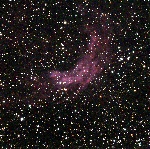 |
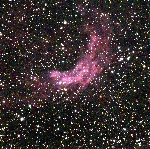 |
| Imax=0.50 | Imax=0.30 |
SBIG ST-4K with 10″ LX200 telescope, 1800s total exposure 2/19/23 Whangaparaoa, NZ
NGC 3199 is a crescent-shaped nebula located near a Wolf-Rayet star in Carina. We could see it visually, but it was faint. This exposure may have also been affected by condensation on the optics.
NGC 3293 - Gem Cluster
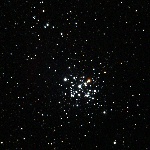 |
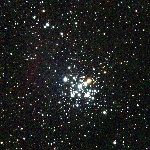 |
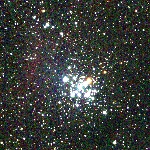 |
| Imax=4 | Imax=1 | Imax=0.50 |
SBIG ST-4K with 10″ LX200 telescope, 300s total exposure 2/20/23 Whangaparaoa, NZ
This cluster was challenging to find. After I finally confirmed a match with the sky atlas, I only had time for one exposure before the sky clouded over. Nevertheless, the color contrast between the stars can be seen, and some emission and reflection nebulae (to the left of the cluster) can also be seen faintly.
NGC 5189 - Spiral Planetary Nebula
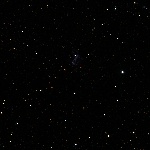 |
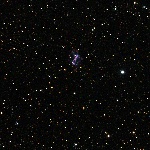 |
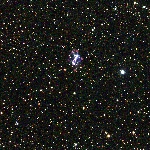 |
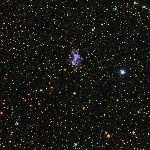 |
| Imax=12 | Imax=3 | Imax=1 | Nonlinear |
SBIG ST-4K with 10″ LX200 telescope, 300s total exposure 2/20/23 Whangaparaoa, NZ
This single guided exposure shows the complicated structure of this planetary nebula in Musca. The highest intensity range (lowest scaled) version on the left shows that the central star has a blue color, as is seen with many planetary nebulae. Visually, it was not difficult to detect the presence of the nebula, but I was not able to discern a spiral structure.
NGC 5139 - Omega Centauri
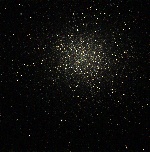 |
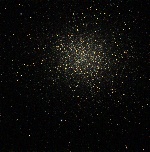 |
| Imax=20 | Nonlinear |
SBIG ST-4K with 10″ LX200 telescope, 160s total exposure 2/16/23 Whangaparaoa, NZ
Omega Centauri is the largest globular cluster in our galaxy and one of the most visually spectacular. However, at a declination of -47°, it barely rises above the horizon in southern states such as Arizona, and it is better observed from the Southern Hemisphere. This image was made from a sequence of 16 unguided exposures, each 10 seconds.
NGC 5128 - Centaurus A
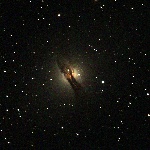 |
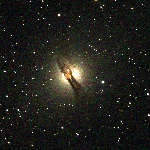 |
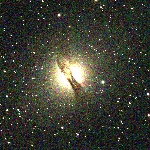 |
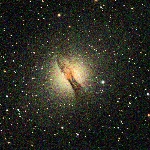 |
| Imax=2 | Imax=1 | Imax=0.50 | Nonlinear |
SBIG ST-4K with 10″ LX200 telescope, 300s total exposure 2/17/23 Whangaparaoa, NZ
Centaurus A is famous both as a radio source and for its striking dust lane, resulting from the merger of a spiral galaxy with an elliptical galaxy. In this photo, I only managed to acquire one frame before the sky clouded over, and already the telescope's corrector plate had a lot of condensation. Nevertheless, the main structures can be seen.
β and DY Crucis
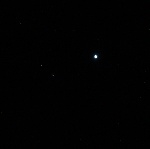 |
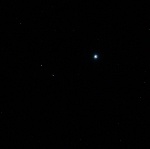 |
| Imax=660 | Nonlinear |
SBIG ST-4K with 10″ LX200 telescope, 20s total exposure 2/20/23 Whangaparaoa, NZ
DY ("Ruby") Crucis is a carbon star near Beta Crucis. Visually, the color was quite red. In this image, made by combining 20 1-second exposures, the usual linear scaling (left) results in an orange-white color because of display saturation. However, with a hue-preserving histogram-equalization scaling (right), the color appears red-orange, and the contrast relative to β, which appears blue-white, is most striking.
Alpha Centauri System
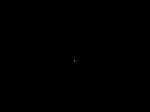 |
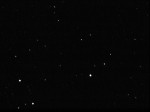 |
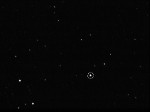 |
| α Cen A and B | Proxima | Proxima (circled) |
Alvium 1800 U-319m with 10″ LX200 telescope 2/22/23 Whangaparaoa, NZ
At a distance of 4.3 ly, the α Centauri system is the closest star system to our own, and it will continue to be for the next 30,000 years. It consists of two sun-like stars A and B and the red dwarf star Proxima. A and B, shown on the left, form a double-star system with a 79-year orbital period, with A approximately three times brighter than B. From the image, I would estimate a separation of approximately 9 arcsec, though the expected current separation is approximately 7.5 arcsec (and increasing), so it is possible the effective focal length at the camera position I used was different than expected. Proxima is physically quite far from A and B, approximately 0.2 ly, with an estimated orbital period of 547,000 years. It is so named because it is 0.1 ly closer to us than A and B. Because Proxima is rather faint (11th magnitude) and more than 2° away from A and B in the sky, it is difficult to identify Proxima amongst the background stars. In the right-most image, I circled the star that I believe is Proxima based on comparison with other images. Another way to confirm its identity would be to image the same field a year or more later, at which time the proper motion should be clearly visible.
